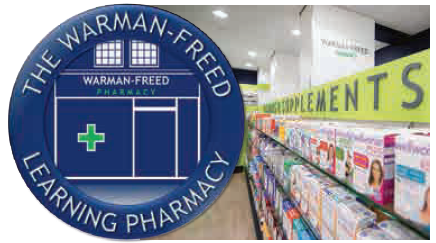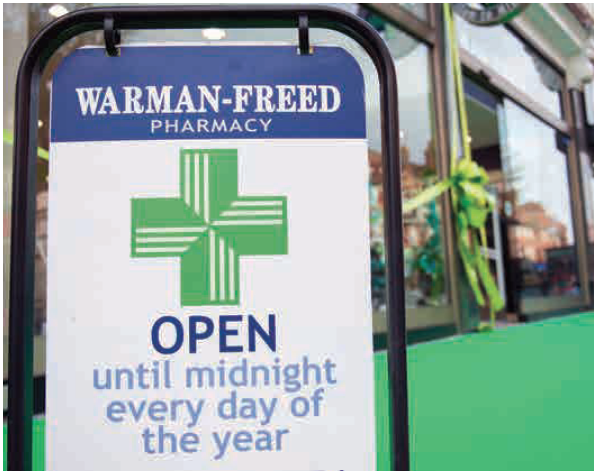Time is money €“ the value of an hour
In CPD
Follow this topic
Bookmark
Record learning outcomes
 The Warman-Freed Learning Pharmacy team discuss how they took steps to understand the value of their time and where their time was best spent, and looked at how they could drive sales through more than just promotions
The Warman-Freed Learning Pharmacy team discuss how they took steps to understand the value of their time and where their time was best spent, and looked at how they could drive sales through more than just promotions
We all know the phrase ‘time is money’, but when you’re looking at your commercial strategy to invest in future success, focusing on the things that can make a big difference to the profitability of your pharmacy is key.
Understanding value
Today, running a pharmacy goes far beyond just dispensing. The basics of retail must also be considered, and this diversification can make it difficult for pharmacy managers to know which avenues offer the best rewards and stand to make the biggest difference to their bottom line.
The team at the Learning Pharmacy have spent six months trialling and analysing various activities to truly understand their commercial potential. Farah Ali, general manager at The Learning Pharmacy, explains: “From staff coaching to drafting and mailing out MUR letters, or running data to identify sales performance and adjusting stock accordingly, we were keen to understand the commercial benefit of each of the activities we invest time in. Through this exercise we were able to identify which activities have an incremental impact on our business and profitability.”
 Understanding how to get the most out of your time starts with knowing what your time is worth. So the team began by calculating the value of an average hour in the pharmacy by adding together the hourly income for the retail and prescription parts to the business.
Understanding how to get the most out of your time starts with knowing what your time is worth. So the team began by calculating the value of an average hour in the pharmacy by adding together the hourly income for the retail and prescription parts to the business.
“Understanding what an average hour is worth to the business was a learning in itself,” says Ms Ali. “With this knowledge in place, it became possible to benchmark and start building a clearer picture of productivity.” The team then developed a list of the other initiatives undertaken at the pharmacy (such as drafting MUR letters and mailing them to patients, staff coaching sessions, identifying stock gaps on shelf and filling them in an order or improving in-store signage). After listing these activities, the Warman-Freed team set about calculating the commercial benefit of each.
“By considering which activities have an impact on the bottom line we were able to prioritise where time is best invested by the team,” says Ms Ali.
“An example is the time spent purchasing an A-frame blackboard, deciding on a key message and placing it in the store to promote our services. The impact of the board was all incremental as we hadn’t previously advertised the services and we were able to benchmark the increase in service uptake against the hour we spent purchasing the board.”
As they reviewed the results, the team saw that there were some unexpected activities that had a significant impact while others had less. “One of our biggest learnings from the project was around the value of staff development,” says Ms Ali. “In taking an hour off the shop floor to conduct one-on-one training with a member of staff around a key development goal, we were able to unlock a significant benefit through in-store services and sales results. This made us realise that time away from the shop floor to invest in training is hugely worthwhile given the longer-term benefits that such an investment holds for service delivery and profitability.”
Understanding into action
There have been multiple applications of the learning gained from this project. The training plan for 2017 now involves an option for oneto- one coaching and category management principles have also been rolled out across other areas of the pharmacy. In addition, the team explored how they could improve in-store and direct-to-customer communications, focusing the team on the right messaging at the right time.
“Prioritising sales over staff is not necessarily the key to commercial success,” says Ms Ali. “Thinking in terms of an ‘average hour’ allows us to put a value on these ‘softer’ aspects of running a pharmacy, which might be deprioritised if we’re only looking at the immediate financial gain.
“We trialled several initiatives over a six-month period, which felt like a feasible way to review the impact. Trying to do everything at once can be stressful and leaves you without knowing what really has had an impact. Doing a few things well can offer a more insightful view of what works for your business, but it’s definitely worth bearing your average hour in mind as you try out new ideas. It gives you a handy measure of success.”
Calculating the value of your time...
Retail business
[Average daily transactions ÷ pharmacy hours open] x [average transaction value]
Prescription business
[Average daily scripts ÷ pharmacy hours open] x [average script value]
Download Warman-Freed’s worksheet here to help guide you to calculate your average hour values.
